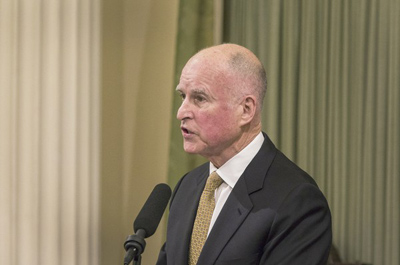
Gov. Jerry Brown has contended that he can meet court-ordered crowding limits by making more inmates eligible for parole. (Ken James, Bloomberg / January 22, 2014)
Gov. Jerry Brown has again asked federal judges for more time to reduce crowding in California's prisons and, in an about-face, proposed to free inmates early if he misses an extended deadline.
California is under orders to remove thousands of inmates from state lockups by April 18, a deadline already delayed more than a year.
In papers filed in U.S. District Court on Thursday, Brown asked for an additional two years. That is "the minimum length of time needed to allow new reform measures to responsibly draw down the prison population while avoiding the early release of inmates," the documents say.
Brown has declared repeatedly that releasing prisoners early would jeopardize public safety. But to assure the court of his good intentions, the governor now proposes that the court appoint a monitor with the power to release prisoners if the state fails to meet a 2016 deadline or a series of smaller benchmarks before then.
The monitor - not Brown's administration - would decide whom to set free, according to the proposal.
Lawyers for inmates made their own filing to the judges Thursday, calling for the appointment of a federal compliance officer to monitor inmate numbers. They called the shift in the governor's position a positive step but said releases should begin now.
"It delays what should have been done years ago," said Don Specter, lead attorney in one of two class-action cases that caused the judges to impose crowding limits four years ago.
The judges, who have been hearing lawsuits over inadequate care of inmates, have suggested they might accept a further delay in return for immediate improvements in that care. But state officials recently conceded that the prison population is growing, not shrinking: As of Wednesday, officials reported that the prisons were at 144% of their designed capacity, with 117,500 inmates.
Brown contends that even so, he can meet the court-ordered crowding limits by making more inmates eligible for parole. In the budget plan he recently released, the governor said he would increase parole options for medically frail and elderly inmates and allow some repeat offenders to shorten their sentences with good behavior.
In Thursday's filing, Brown said he was also willing to consider paroling some repeat felons, sentenced under California's "three strikes" law, if they have served at least half of their sentences. The offer would be restricted to those convicted of a second strike - which comes with a doubled sentence - if that crime was not violent.
Brown also proposes immediately releasing murderers and other inmates serving life sentences who already have been deemed suitable for parole but were given future release dates.
Christine Ward, director of the Sacramento-based Crime Victims Action Alliance, was upset by the state's proposal. "We are in just a horrible, horrible, horrible position right now, with the courts forcing the state to come up with ridiculous plans of action," she said. "If the wrong people are let out, somebody could be killed."
The governor agreed to set aside $81 million for rehabilitation programs if the court agrees to the two-year delay. He also expressed an intention to open pre-release centers at 13 prisons within the year to help inmates prepare for freedom.
California has more than 12,000 prisoners in private prisons and county-run facilities, according to reports by the corrections department. The court filing states that a two-year delay would avoid "sending thousands more inmates to private prisons in other states."
In a proposed order included in the filing, the administration admits that even if granted more time, the state intends to lease more cells in private prisons, county jails and community-owned corrections centers.











